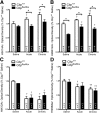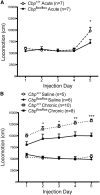CBP in the nucleus accumbens regulates cocaine-induced histone acetylation and is critical for cocaine-associated behaviors
- PMID: 22114264
- PMCID: PMC3235434
- DOI: 10.1523/JNEUROSCI.2747-11.2011
CBP in the nucleus accumbens regulates cocaine-induced histone acetylation and is critical for cocaine-associated behaviors
Abstract
Cocaine exposure triggers molecular events that lead to long-lasting changes in brain structure and function. These changes can lead to the development of persistent and robust behavioral adaptations that characterize addiction. Recent evidence suggests the regulation of transcription via chromatin modification, such as histone acetylation, has an important role in the development of addictive behavior. Histone acetylation is regulated by histone acetyltransferases (HATs), which acetylate histones and promote transcription, and histone deacetylases (HDACs), which remove acetyl groups and silence transcription. Studies have demonstrated that HDACs may negatively regulate cocaine-induced behaviors, but very little is known about the role of specific HATs in long-lasting drug-induced plasticity. The histone acetyltransferase CREB-binding protein (CBP) mediates transcriptional activation by recruiting basal transcription machinery and acetylating histones. CBP is a critically important chromatin-modifying enzyme involved in regulating gene expression required for long-term plasticity and memory. However, the role of CBP in cocaine-induced behaviors remains largely unknown. We examined the role of CBP in drug-induced plasticity using CBP-FLOX genetically modified mice in combination with adeno-associated virus expressing Cre-recombinase to generate focal homozygous deletions of Cbp in the nucleus accumbens (NAc). A complete loss of CBP in NAc neurons results in decreased histone acetylation and significantly altered c-fos expression in response to cocaine. Furthermore, the deletion of CBP in the NAc correlates with significant impairments in cocaine sensitivity and context-cocaine associated memory. This is the first study to demonstrate a definitive role for CBP in modulating gene expression that may subserve drug-seeking behaviors.
Figures





References
-
- Alarcón JM, Malleret G, Touzani K, Vronskaya S, Ishii S, Kandel ER, Barco A. Chromatin acetylation, memory, and LTP are impaired in CBP+/− mice: a model for the cognitive deficit in Rubinstein-Taybi syndrome and its amelioration. Neuron. 2004;42:947–959. - PubMed
-
- Bhat RV, Cole AJ, Baraban JM. Chronic cocaine treatment suppresses basal expression of zif268 in rat forebrain: in situ hybridization studies. J Pharmacol Exp Ther. 1992;263:343–349. - PubMed
Publication types
MeSH terms
Substances
Grants and funding
LinkOut - more resources
Full Text Sources
Molecular Biology Databases
